Oriental Carpets in the Philadelphia Museum of Art
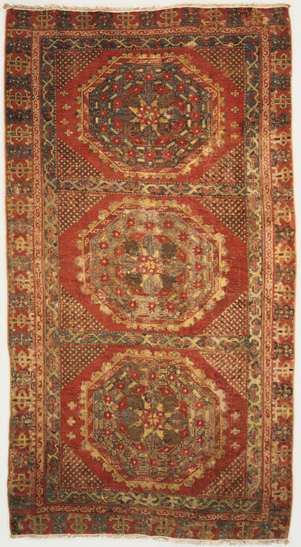 | Wheel Rug Made in TurkeyPossibly made in Konya, Anatolia 15th - 16th century Artist/maker unknown, Turkish Wool and possibly goat hair * Gallery 205, European Art 1100-1500, second floor 1943-40-67 The John D. McIlhenny Collection, 1943 This is the finest example in an American collection of the Turkish "wheel rugs," so named in European inventories of the fifteenth and sixteenth centuries for their wheel-like pattern of octagons filled with interlaced geometric forms. The pattern can also be found in many Spanish rugs and European paintings of the period. |
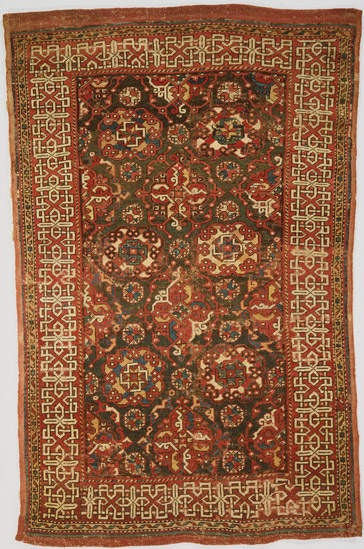 | "Holbein" Rug Possibly made in Wallachia, Romaniaor Anatolia, Konya, Turkey 16th - 17th century Artist/maker unknown, Turkish Wool Currently not on view 1955-65-3 The Joseph Lees Williams Memorial Collection, 1955 |
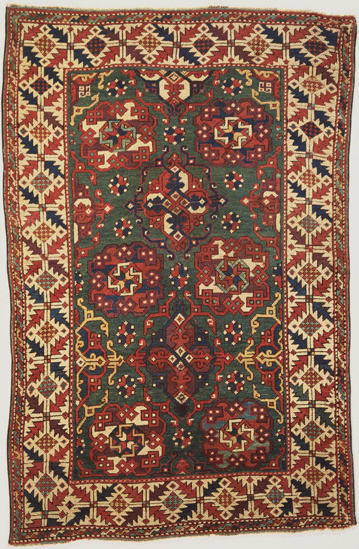 | "Holbein" Rug Possibly made in Wallachia, Romaniaor Central Anatolia, Turkey 17th century Artist/maker unknown, Turkish Wool * Gallery 221, Asian Art, second floor 1955-65-5 The Joseph Lees Williams Memorial Collection, 1955 The characteristic delicate, lacy pattern of this rug is named for the Netherlandish painter Hans Holbein the Younger, who reproduced it in paintings between 1527 and 1543. Though still in common use today, the term “Holbein” rug is misleading because it was not used by Turkish weavers and this type of carpet was first depicted by European painters long before Holbein was born. |
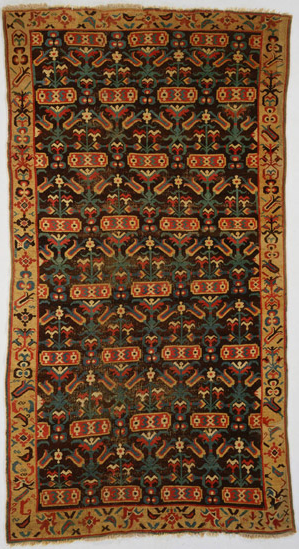 | Kilim-Style Rug Made in Central Anatolia, Turkey18th - 19th century Artist/maker unknown, Turkish Wool and possibly goat hair Currently not on view 1973-2-1 Gift of Henry P. McIlhenny, 1973 This unusual pattern of geometrically arranged floral motifs, brightly colored against a brown-black background, is reminiscent of the designs on Turkish ceramics. |
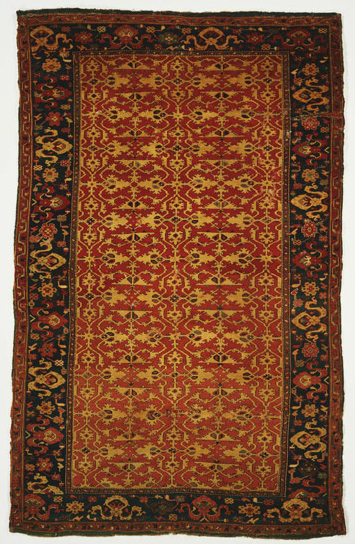 | "Lotto" Rug Made in TurkeyPossibly made in Ushak, Anatolia 16th century? Artist/maker unknown, Turkish Wool Currently not on view 1955-65-10 The Joseph Lees Williams Memorial Collection, 1955 |
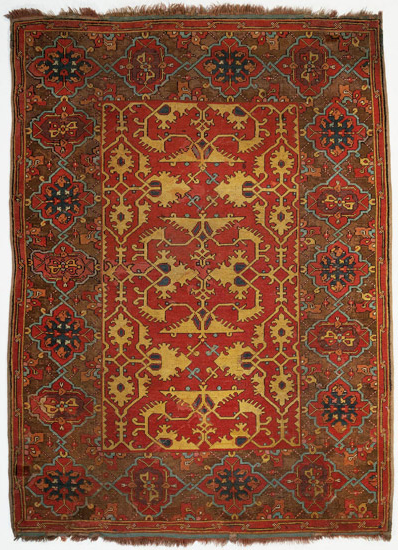 | "Lotto" Rug Possibly made in Wallachia, Romania17th century? Artist/maker unknown, Turkish, European Wool * Gallery 261, European Art 1500-1850, second floor Cat. 1160 John G. Johnson Collection, 1917 |
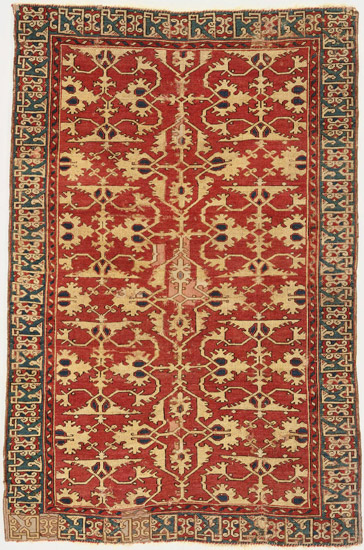 | "Lotto" Rug Made in Anatolia, TurkeyPossibly made in Konya, Anatolia 16th century Artist/maker unknown, Turkish Wool and possibly goat hair Currently not on view 1967-30-308 The Samuel S. White 3rd and Vera White Collection, 1967 The "Lotto" pattern of arabesque forms in this carpet may derive from Persian silk textiles. The term "Lotto" came into use after rugs with this pattern appeared in paintings by the sixteenth-century Venetian artist Lorenzo Lotto. |
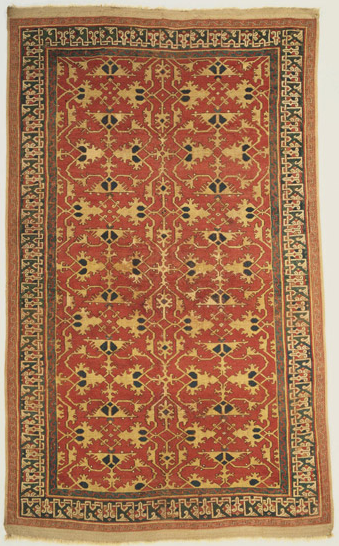 | " Lotto" Rug Made in Turkey 16th century? Artist/maker unknown, Turkish Wool and possibly goat hair * Gallery 221, Asian Art, second floor 1943-40-68 The John D. McIlhenny Collection, 1943 |
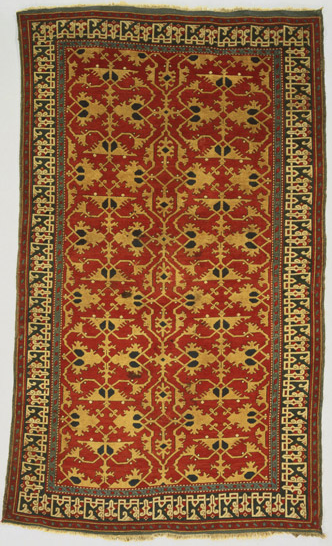 | "Lotto" Rug Made in TurkeyPossibly made in Konya, Anatolia 16th century Artist/maker unknown, Turkish Wool and possibly goat hair Currently not on view 1955-65-9 The Joseph Lees Williams Memorial Collection, 1955 "Lotto" is a term of convenience for the repeated pattern of arabesque forms used in many sixteenth- and seventeenth-century Turkish rugs. The term is taken from the name of the sixteenth-century Venetian artist Lorenzo Lotto, whose paintings depict rugs with this pattern. |
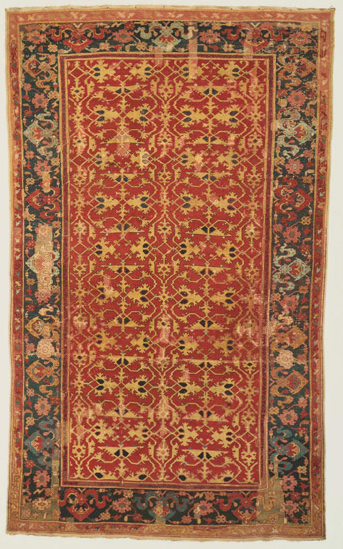 | "Lotto" Rug Made in TurkeyPossibly made in Ushak, Anatolia Late 16th century Artist/maker unknown, Turkish Wool and possibly goat hair Currently not on view 1948-83-2 Gift of the Sharples family in memory of Philip M. Sharples, 1948 |
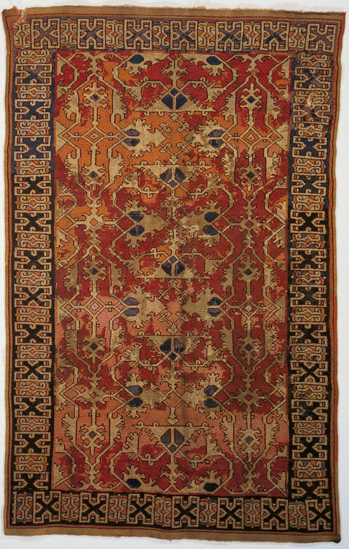 | "Lotto" Rug Possibly made in Anatolia, Konya, Turkey17th century? Artist/maker unknown, Turkish Wool and goat hair Currently not on view Cat. 1159 John G. Johnson Collection, 1917 |
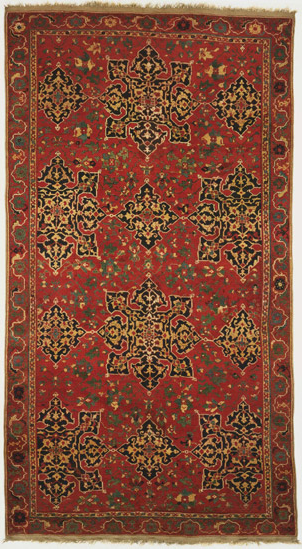 | Star Ushak Rug Made in Ushak, Anatolia, Turkey17th century Artist/maker unknown, Turkish Wool and possibly goat hair * Gallery 221, Asian Art, second floor 1955-65-16 The Joseph Lees Williams Memorial Collection, 1955 This carpet’s pattern of eight-pointed star medallions and diamond forms makes it an especially attractive example of the Ushak weaver’s craft. |
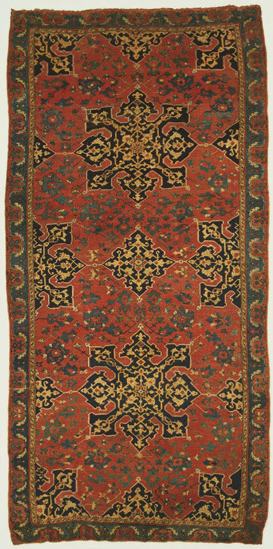 | Star Ushak Rug Made in Ushak, Anatolia, Turkey17th century Artist/maker unknown, Turkish Wool, cotton, and possibly goat hair * Gallery 221, Asian Art, second floor 1943-40-66 The John D. McIlhenny Collection, 1943 |
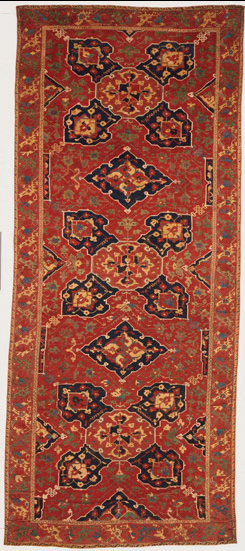 | Quatrefoil Rug Made in Ushak, Anatolia, Turkey17th century Artist/maker unknown, Turkish Wool * Gallery 206, European Art 1100-1500, second floor 1955-65-1 The Joseph Lees Williams Memorial Collection, 1955 The design on this carpet is the only known complete example of alternating large quatrefoil medallions and smaller diamonds. |
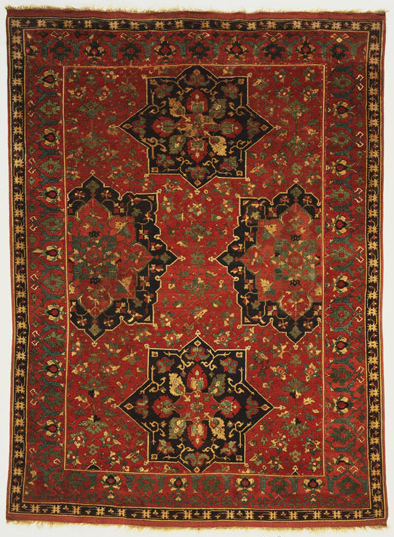 | Octogram Medallion Rug Made in Ushak, Anatolia, Turkey17th century Artist/maker unknown, Turkish Wool Currently not on view 1955-65-13 The Joseph Lees Williams Memorial Collection, 1955 The medallions on this rug take the form of the octagram, an eight-pointed star. |
 | Medallion Carpet Made in Ushak, Anatolia, Turkey16th - 17th century Artist/maker unknown, Turkish Wool and possibly goat hair * Gallery 221, Asian Art, second floor 1955-65-15 The Joseph Lees Williams Memorial Collection, 1955 This carpet remains one of the finest examples of its type, despite numerous reweavings and fading. The complex pattern of floral motifs and arabesques, with two types of medallions in rows, testifies to the skill of the weavers. |
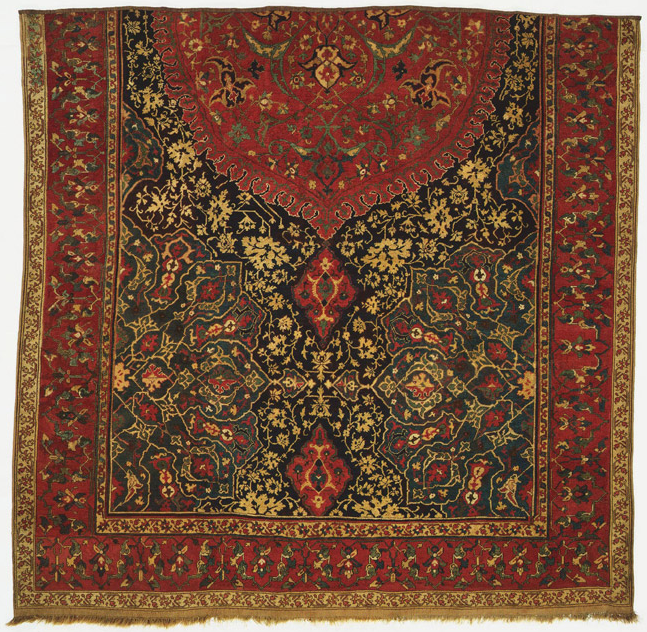 | Medallion Carpet Fragment Made in Ushak, Anatolia, TurkeyEarly 17th century Artist/maker unknown, Turkish Wool and possibly goat hair * Gallery 221, Asian Art, second floor 1955-65-14 The Joseph Lees Williams Memorial Collection, 1955 When complete, this rug was dominated by a pointed oval medallion, the lower half of which can be seen here. |
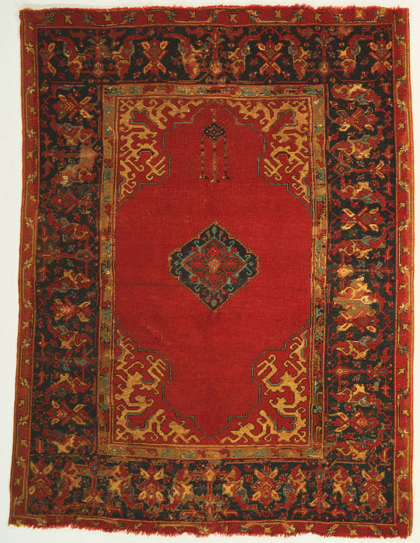 | Prayer Rug Made in Ushak, TurkeyLate 16th century Artist/maker unknown, Turkish Wool Currently not on view 1943-40-59 The John D. McIlhenny Collection, 1943 A mosque lamp hangs in one of the two opposing arches of the central field of this rug. Small rugs of this type were used for kneeling during prayer. |
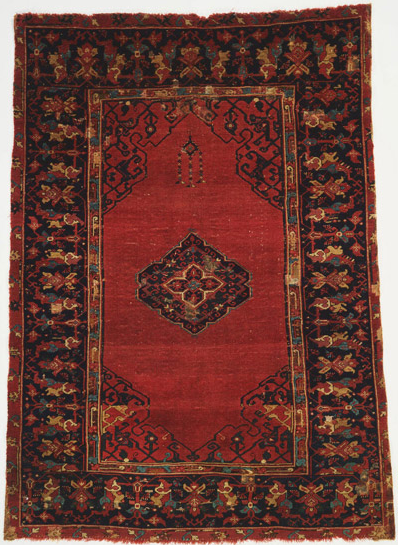 | Opposed-Arch Rug Possibly made in Wallachia, Romaniaor Ushak, Anatolia, Turkey 17th century Artist/maker unknown, Turkish, European? Wool * Gallery 221, Asian Art, second floor 1955-65-17 The Joseph Lees Williams Memorial Collection, 1955
|
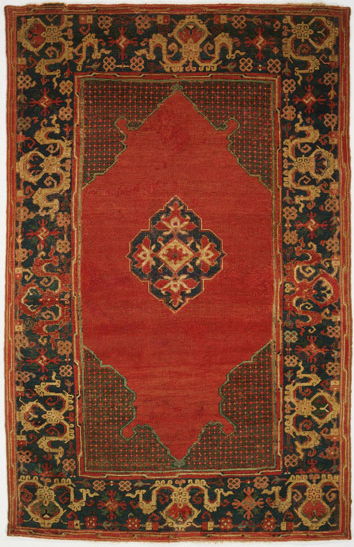 | Opposed-Arch Rug Possibly made in Central Anatolia, Turkey17th century Artist/maker unknown, Turkish, European or central Anatolia Wool * Gallery 221, Asian Art, second floor 1955-65-18 The Joseph Lees Williams Memorial Collection, 1955 |
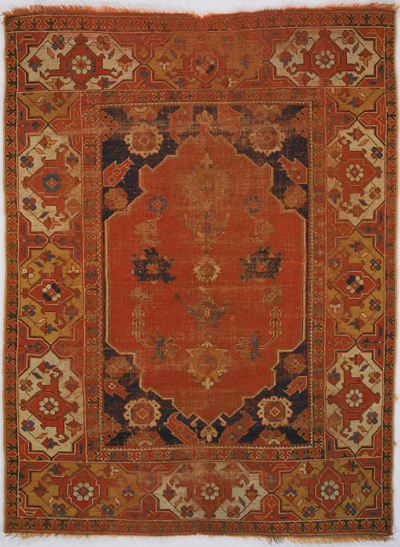 | Transylvanian Rug Possibly made in Wallachia, RomaniaEarly 18th century? Artist/maker unknown, Turkish, European Wool * Gallery 221, Asian Art, second floor 1977-99-1 Gift of Suzanne and Joseph Lees Eastwick, 1977 |
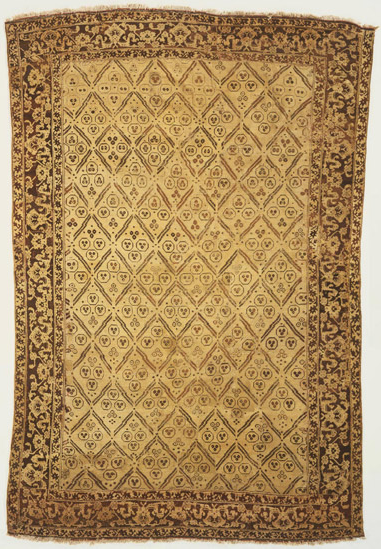 | Chintamani Rug Made in Anatolia, Turkey17th century Artist/maker unknown, Turkish Wool and possibly goat hair Currently not on view 1943-28-5 The John D. McIlhenny Collection, bequest of Mrs. John D. McIlhenny, 1943 Chintamani is the name for the East Asian Triple Jewel symbol and is used for Turkish rugs covered with rows of three small circles, one atop the others, above one or two wavy lines. The pattern may have also been based on the leopard spots and tiger stripes of Central and East Asian royal furs. |
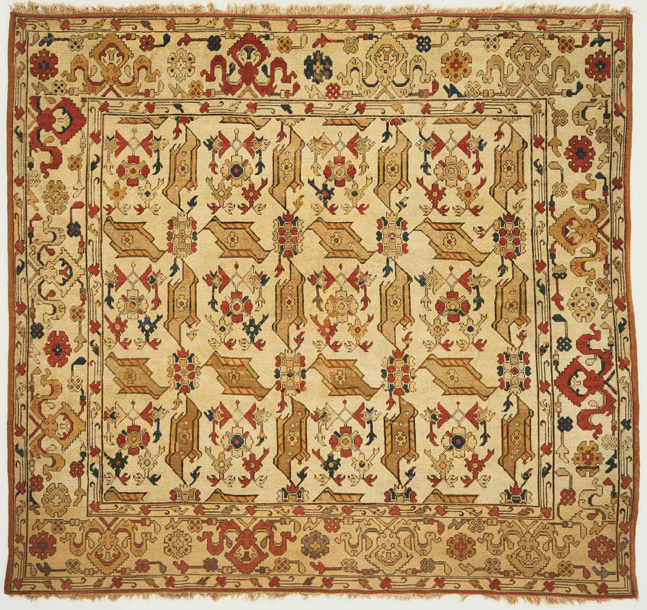 | "Bird" Rug Made in Wallachia, Romania17th century Artist/maker unknown, Turkish, European Wool Currently not on view 1943-28-2 The John D. McIlhenny Collection, bequest of Mrs. John D. McIlhenny, 1943 The stylized leaf forms on this white-ground rug have been thought to resemble hummingbirds, thus leading to the term "bird" rug. |
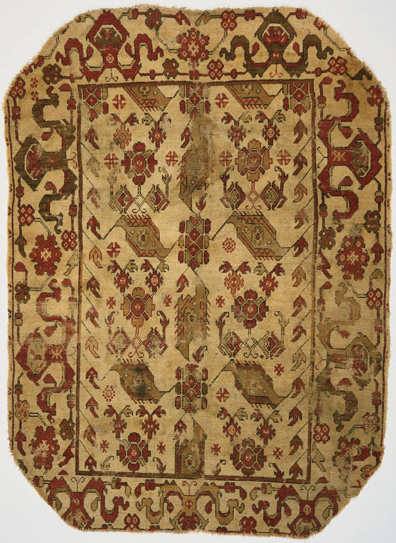 | "Bird" Rug Possibly made in Wallachia, Romania17th century Artist/maker unknown, Turkish Wool * Gallery 221, Asian Art, second floor 1955-65-12 The Joseph Lees Williams Memorial Collection, 1955 Many small “bird” rugs of this type have been found in Protestant churches in Transylvania, where they were used to decorate benches, corridors, and the like. The corners of this rug may have been cropped for some architectural purpose. |
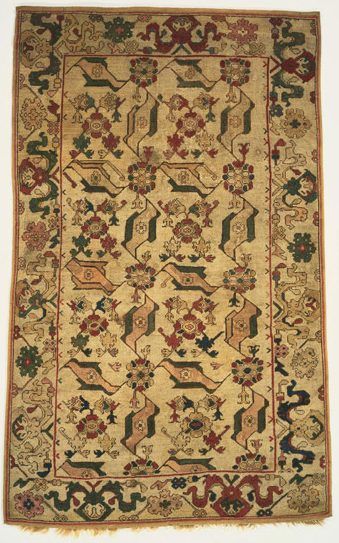 | "Bird" Rug Possibly made in Wallachia, Romania17th century Artist/maker unknown, Turkish Wool and possibly goat hair * Gallery 221, Asian Art, second floor 1955-65-11 The Joseph Lees Williams Memorial Collection, 1955
|
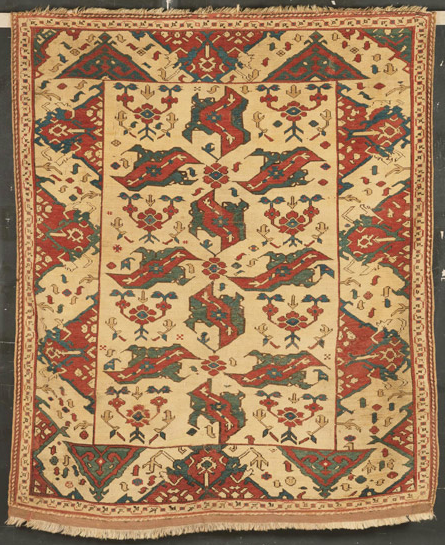 | "Bird" Rug Made in Anatolia, Turkey17th - 18th century Artist/maker unknown, Turkish Wool * Gallery 221, Asian Art, second floor 1943-28-3 The John D. McIlhenny Collection, bequest of Mrs. John D. McIlhenny, 1943 |
| | |
 | Prayer Carpet Made in TurkeyOttoman Empire (c.1300-1919), 19th century Artist/maker unknown, Turkish Wool plain weave with wool appliqué and silk and silver gilt thread embroidery in couching stitch Currently not on view 1965-118-10 Gift of Clayton F. Banks, Jr., 1965 |
 |
"Admiral" Heraldic Carpet Made in Spainc. 1429-73 Artist/maker unknown, Spanish, possibly woven by Muslim craftsmen Wool * Gallery 206, European Art 1100-1500, second floor 1955-65-21 The Joseph Lees Williams Memorial Collection, 1955
Shortly after the Muslims of North Africa introduced the art of making twisted-pile carpets into Spain, the weaving of this armorial carpet was undertaken. It was probably made for the founder of the royal house of Castile, Fadrique Enríquez, who held the titles of Lord of Medina and Admiral of Castile and was the grandfather of King Ferdinand of Spain. His coat of arms—an upright lion beneath two triple-towered castles bordered by anchors and ropes—is repeated three times in the center field. A decorative pattern in the main border at each end, formed by designs that resemble Arabic script, indicates its Mudéjar workmanship. |
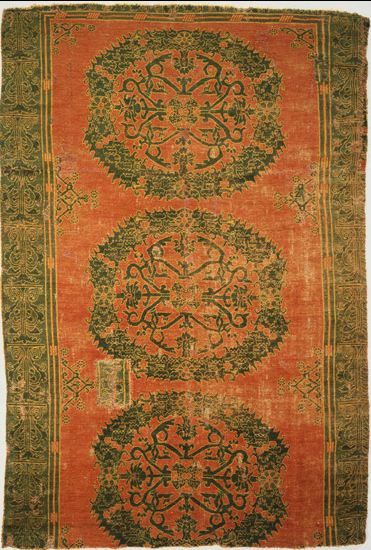 | Wreath Rug Fragment Made in Alcaraz, SpainMid- 16th century Artist/maker unknown, Spanish Wool, bast fiber (probably flax), and possibly goat hair Currently not on view 1955-65-36 The Joseph Lees Williams Memorial Collection, 1955 This rug shows some of the changes in design between the rugs woven in Turkey (Anatolia) and Spain in the sixteenth century. Here, three laurel wreaths in blue-green replace the pattern used in the "wheel rugs" of Turkey. The floral border has been borrowed from Renaissance textiles, and the coral color, produced from a dye newly imported into Spain from Mexico, replaces the red normally used in Turkish rugs. |
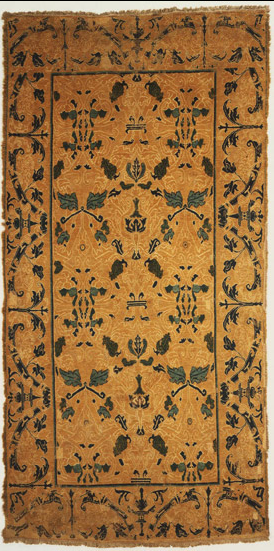 | Ogival Lattice Carpet Made in Alcaraz, Spain16th century Artist/maker unknown, Spanish Wool or goat hair * Gallery 205, European Art 1100-1500, second floor 1955-65-22 The Joseph Lees Williams Memorial Collection, 1955 "Ogival lattice" refers to the vine and leaf pattern marked off by ivory lines on this rug. Due to fading of the dyes, the lattice pattern has lost much of its original prominence. |
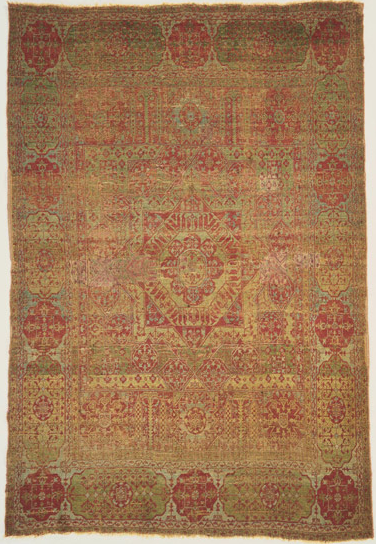 | Mamluk Rug Made in Cairo, Egypt1500-1550 Artist/maker unknown, Egyptian Wool * Gallery 205, European Art 1100-1500, second floor 1943-40-63 The John D. McIlhenny Collection, 1943 Mamluk carpets are characterized by a central, dominant octagonal medallion surrounded by a great variety of smaller, geometric motifs. They take their name from the Mamluk dynasties that ruled Egypt from 1250 through 1517. Carpets of this design were produced in Cairo, largely for the southern European luxury trade. |
 | Mamluk Rug Made in Cairo, EgyptLate 15th century Artist/maker unknown, Egyptian Wool * Gallery 205, European Art 1100-1500, second floor 1955-65-8 The Joseph Lees Williams Memorial Collection, 1955 Among the Egyptian Mamluk rugs that survive, the design of this rug is quite unusual. Its peculiarity lies in the central group of nine rondels, reminiscent of mandala arrangements in East Asian art, and in the prominent yellow-white lotus blossoms, also of Asian origin, in the border. |
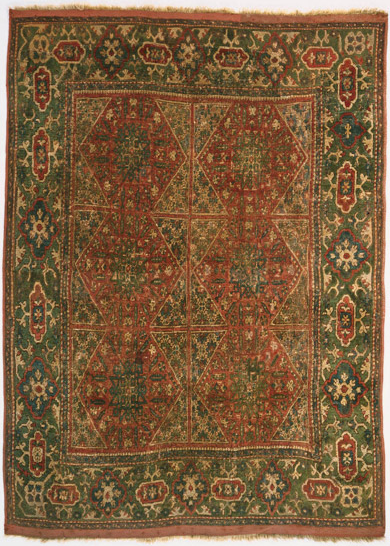 | Compartment Rug Made in SyriaPossibly made in Damascus, Syria Early 17th century Artist/maker unknown, Syrian Wool and possibly goat hair * Gallery 205, European Art 1100-1500, second floor 1955-65-6 The Joseph Lees Williams Memorial Collection, 1955 The design on the Weld of this carpet—hexagons placed in a continuous grid of rectangular compartments—as well as the border design, is thought to be inspired by the older Mamluk rugs of Egypt. |
 | Dragon Rug Made in IranPossibly made in Kurdistan 18th century Artist/maker unknown, Iranian, Persian, Kurdistan? Wool and cotton * Gallery 206, European Art 1100-1500, second floor 1955-65-23 The Joseph Lees Williams Memorial Collection, 1955 This is the only known dragon rug that has been knotted in the Persian manner. The last twelve inches of the carpet, woven in the opposite direction from the rest of its length, is also an unusual structural feature. This may be because the weaver was migratory and had to remove the carpet from the loom in order to move. When the weaving resumed, the rug was mounted on the loom in the opposite direction. |
 | "Afshan" Floral Rug Fragment Possibly made in Shusha, Caucasus, Karabagh Province18th or 19th century Artist/maker unknown, Caucasian Wool Currently not on view 1943-40-73 The John D. McIlhenny Collection, 1943 |
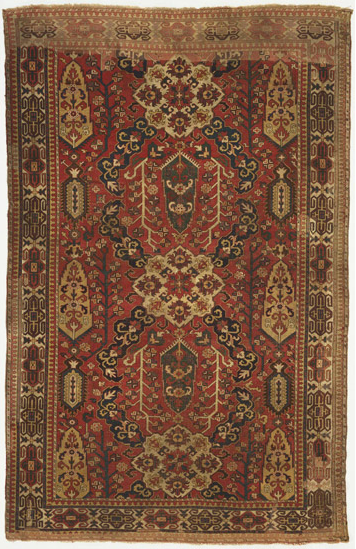 | Cypress-Patterned Rug Fragment Possibly made in Shusha, Caucasus, Karabagh Province18th century Artist/maker unknown, Caucasian Wool Currently not on view 1943-40-74 The John D. McIlhenny Collection, 1943 Stylized, column-like cypress trees in blue-green separate the ivory-colored plaques in the center of this rug, while yellow cypresses alternate with elongated hexagons along the sides. Cypress trees were a popular symbol of eternal life because they stay green year-round in the arid climates of the Middle Eastern countries. |
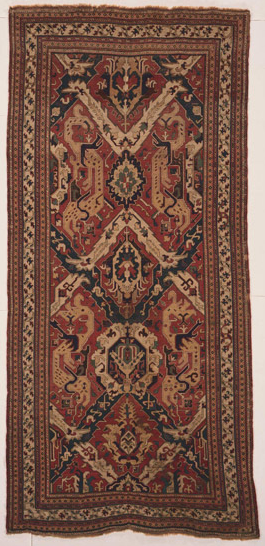 | Dragon Rug Possibly made in Shusha, Caucasus, Karabagh Province18th century Artist/maker unknown, Caucasian Wool * Gallery 206, European Art 1100-1500, second floor 1943-40-65 The John D. McIlhenny Collection, 1943 Two pairs of stylized, yellow dragons appear within the larger red panels on either side of the central axis. |
 | Dragon Rug Possibly made in Shemakha, Caucasus, Shirvan Province17th - 18th century Artist/maker unknown, Caucasian Wool * Gallery 206, European Art 1100-1500, second floor 1948-83-1 Gift of the Sharples family in memory of Philip M. Sharples, 1948 Three pairs of stylized, black-brown dragons are the focus of this bold and striking carpet. The dragon motif originated in China and became widely known from Persian miniature paintings. |
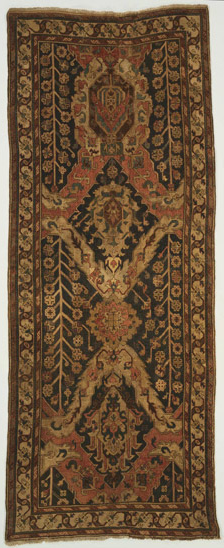 | Dragonless Dragon Rug Possibly made in Shusha, Caucasus, Karabagh Province18th century Artist/maker unknown, Caucasian Wool Currently not on view 1943-40-62 The John D. McIlhenny Collection, 1943 |
 | Para-Mamluk Rug Made in TurkeyPossibly made in Konya, Anatolia 15th - 16th century Artist/maker unknown, Turkish Wool and possibly goat hair Currently not on view 1955-65-2 The Joseph Lees Williams Memorial Collection, 1955 Para-Mamluk carpets were probably made in Anatolia, in workshops founded by craftsmen trained in the Mamluk carpet traditions of Egypt. They share some Mamluk details in their design, most notably rows of small trees and plants arranged around a central octagon. |
 | Compartment and Tree Rug Fragment Made in Kurdistan or Hamadan District, Iran18th century or later Artist/maker unknown, Iranian, Persian Wool and cotton * Gallery 206, European Art 1100-1500, second floor 1943-28-4 The John D. McIlhenny Collection, bequest of Mrs. John D. McIlhenny, 1943 One of the oldest surviving examples of its type, this rug shows a field of leafy or pomegranate-bearing trees arranged between rows of geometric compartments. |
 | Shrub Rug Made in Kirman, IranLate 17th century Artist/maker unknown, Iranian, Persian Wool, cotton, and silk * Gallery 223, Asian Art, second floor 1955-65-27 The Joseph Lees Williams Memorial Collection, 1955 |
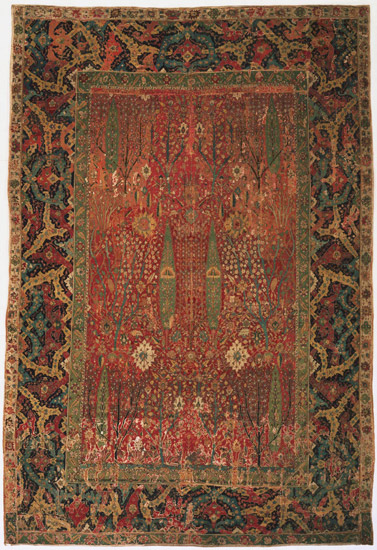 | Tree Carpet Made in Iran 16th - 17th century Artist/maker unknown, Iranian, Persian Wool, cotton * Gallery 206, European Art 1100-1500, second floor 1955-65-25 The Joseph Lees Williams Memorial Collection, 1955 |
 | Vase Carpet Fragment Made in Kirman, IranMid- 17th century Artist/maker unknown, Iranian, Persian Wool and cotton * Gallery 223, Asian Art, second floor 1955-65-28 The Joseph Lees Williams Memorial Collection, 1955 |
 | Vase Carpet Border Fragment Made in Kirman, IranLate 17th century Artist/maker unknown, Iranian, Persian Wool and cotton Currently not on view 1955-65-39 The Joseph Lees Williams Memorial Collection, 1955 |
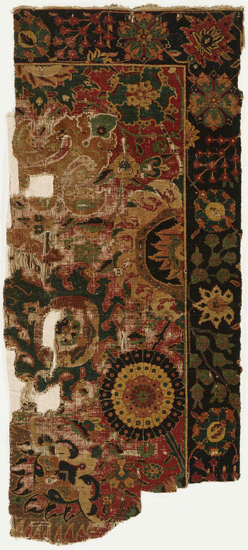 | Vase Carpet Fragment Made in Kirman, Iran16th - 17th century Artist/maker unknown, Iranian, Persian Wool Currently not on view 1955-65-40 The Joseph Lees Williams Memorial Collection, 1955 |
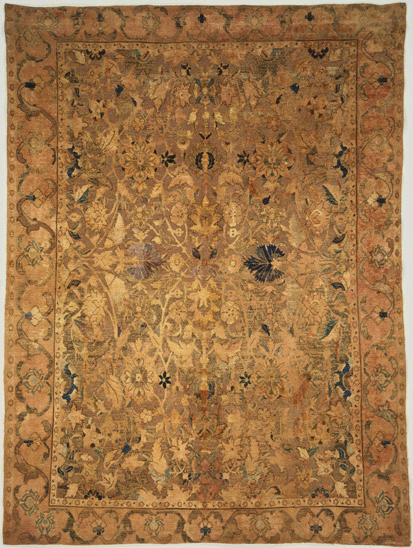 | "Polish" Rug Made in Iran17th century Artist/maker unknown, Persian Silk and cotton Currently not on view 1955-65-31 The Joseph Lees Williams Memorial Collection, 1955 |
 | Marquand Medallion Carpet Made in Anatolia, TurkeyPossibly made in Hereke, Anatolia Mid- 19th century Artist/maker unknown, Turkish Wool, silk, and cotton; silver brocade with traces of gilding * Gallery 223, Asian Art, second floor 1943-28-1 The John D. McIlhenny Collection, bequest of Mrs. John D. McIlhenny, 1943 |
| | |
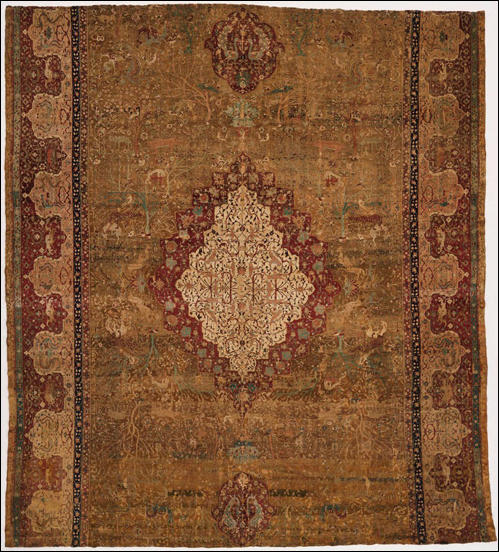 | Medallion and Animal Carpet Fragment Made in IranPossibly made in Kirman 17th century Artist/maker unknown, Iranian, Persian Wool, silk, and cotton Currently not on view 1955-65-26 The Joseph Lees Williams Memorial Collection, 1955 The design for this carpet, depicting a royal pleasure garden and hunting ground with a myriad of plants and animals, must have been created by an artist versed in the Persian miniature painting tradition. The diamond medallion in the center has no close parallel among surviving rugs from Persia. |
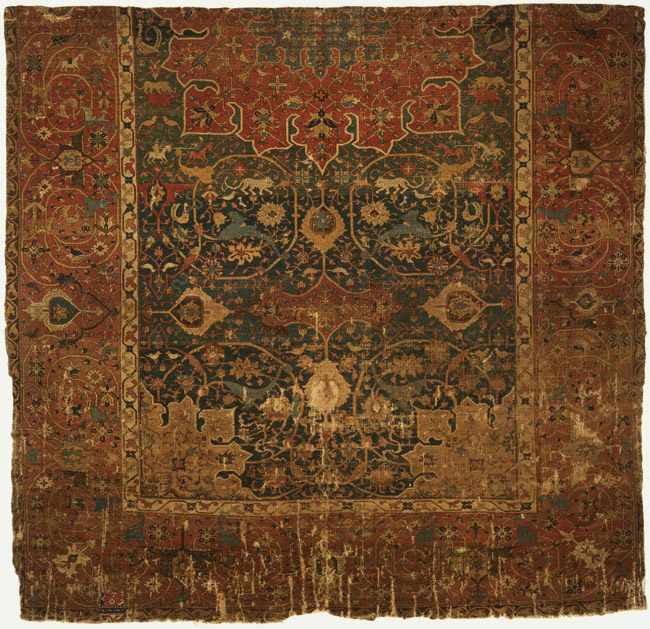 | Medallion Carpet Fragment Made in IranNear Tabriz 16th century Artist/maker unknown, Iranian, Persian Wool and cotton Currently not on view 1955-65-42 The Joseph Lees Williams Memorial Collection, 1955 |
 | Bath Mat Conventionalized floral border surrounding central floral medallion. Made in IranQajar Dynasty (1794-1925), 19th century Artist/maker unknown, Persian Silk plain weave with silk and gilt thread embroidery in straight and split stitches and diamond quilting Currently not on view 1877-134 Purchased with Museum funds, 1877 |
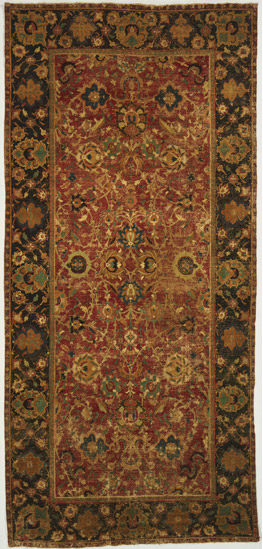 | Vine-Scroll and Palmette Rug Made in IndiaPossibly made in Agra, Uttar Pradesh, India 17th century Artist/maker unknown, India Wool and cotton * Gallery 223, Asian Art, second floor 1955-65-29 The Joseph Lees Williams Memorial Collection, 1955 |
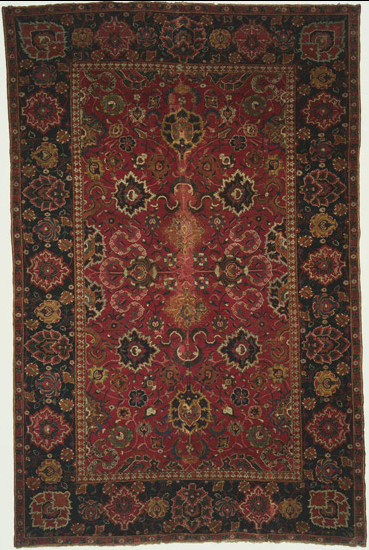 | Palmette and Cloud Band Rug Made in IndiaPossibly made in Agra, Uttar Pradesh, India 17th, 19th, or early 20th century Artist/maker unknown, India Wool and cotton * Gallery 223, Asian Art, second floor 1941-98-1 Gift of Chester W. Larner, 1941 |
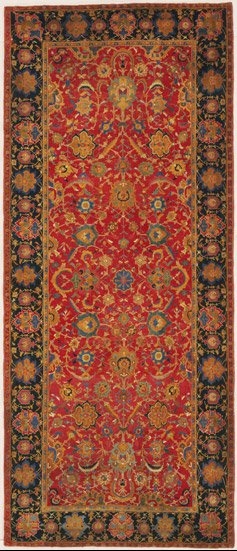 | Vine-Scroll and Palmette Rug Made in IndiaPossibly made in Agra, Uttar Pradesh, India 17th century Artist/maker unknown, India Wool * Gallery 223, Asian Art, second floor 1977-167-1050 Bequest of Carl Otto Kretzschmar von Kienbusch, 1977 |
 | Summer Carpet or Floor Spread Made in IndiaBefore 1690 Artist/maker unknown, India Cotton plain weave with hand drawing and painting Currently not on view 1943-51-126 Bequest of Mrs. Harry Markoe, 1943 This fragment of a seventeenth-century imperial Mughal summer carpet or floor spread was formerly in the collection of the Amber Palace near Jaipur, India. As was the practice with furnishing textiles in royal collections, it was inscribed upon entering the palace with its size, date, and price, and marked again during periodic inventories. The inscriptions on the reverse of this fragment indicate that the floor spread was first inventoried on April 7, 1690, when its cost was listed as 21 rupees, 12 annas; a second inscription records that it was still in use on September 6, 1701. A third of its original size, the Museum's carpet consists of a floral-patterned field bordered on three sides with a different floral fabric. The designs on both the field and the border, like those on other high-quality Indian chintz textiles of the period, were drawn and painted by hand, and show a repeat of formal flowering plants symmetrically arranged against plain backgrounds in patterns that are typical of Mughal decoration beginning in the early seventeenth century. Dilys Blum, from Philadelphia Museum of Art: Handbook of the Collections (1995), p. 74. |
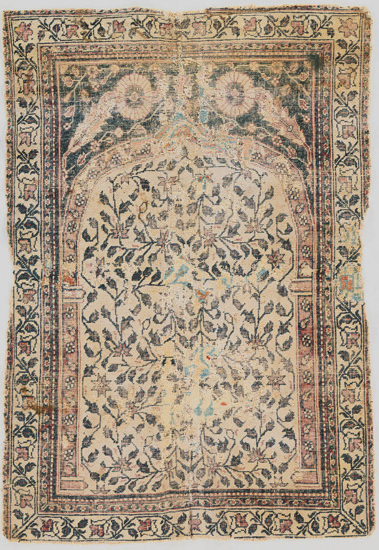 | Prayer Carpet Made in India17th century Artist/maker unknown, India Cotton Currently not on view 1955-65-20 The Joseph Lees Williams Memorial Collection, 1955 |
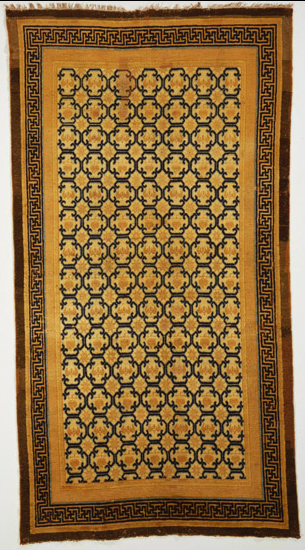 | Rug Possibly made in Ningxia Huizu Zizhiqu, ChinaQing Dynasty (1644-1911), 19th century Artist/maker unknown, Chinese Wool, cotton Currently not on view 1972-232-1 Gift of Carl Otto Kretzschmar von Kienbusch, 1972 |
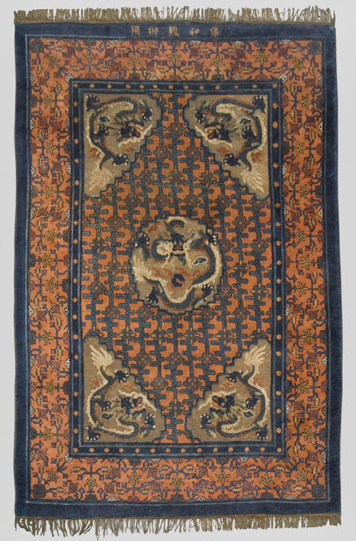 | Carpet Made in ChinaQing Dynasty (1644-1911), 19th century Artist/maker unknown, Chinese Silk * Gallery 240, Asian Art, second floor (Hollis Scholar's Study) 1991-38-1 Gift of Dr. and Mrs. Paul G. Ecker, 1991 |
return to rugrabbit's profile to view additional compilations and exhibitions... http://rugrabbit.com/profile/439
- Home
- Antique Rugs by Region
- Category
- Profiles
- Post Items Free
- Albums
- Benaki Museum of Islamic Art
- Budapest: Ottoman Carpets
- Gulbenkian Museum
- Islamic Carpets. Brooklyn
- Islamic Textiles. Brooklyn
- Konya Museum: Rugs
- MKG, Hamburg
- MMA: Caucasian Carpets
- MMA: Mamluk Carpets
- MMA: Mughal Indian Carpets
- MMA: Ottoman Carpets
- MMA: Safavid Persian Carpets
- MMA: Turkmen Rugs
- McCoy Jones Kilims
- Ottoman textiles. Met
- Philadelphia Museum
- Rugs and Carpets: Berlin
- Seljuqs at the Met
- TIEM, Istanbul: Carpets
- V&A: Classical Carpets
- Vakiflar Carpets: Istanbul
- Baluch Rugs: Indianapolis
- Gallery Exhibitions
- Jaf an Exhibition
- Alberto Levi Gallery
- Andean Textile
- Christie's London: 2016
- Francesca Galloway
- HALI at 40
- ICOC Washington, DC 2018
- Jajims of the Shahsavan
- London Islamic Week April, 2018
- Mongolian Felts
- Navajo Rugs: JB Moore
- Persian Piled Weavings
- SF Tribal & Textile Art Show 2020
- SF Tribal 2019
- Sotheby's: C. Alexander
- Turkish Prayer Rugs
- Turkmen Main Carpets ICOC 2007






